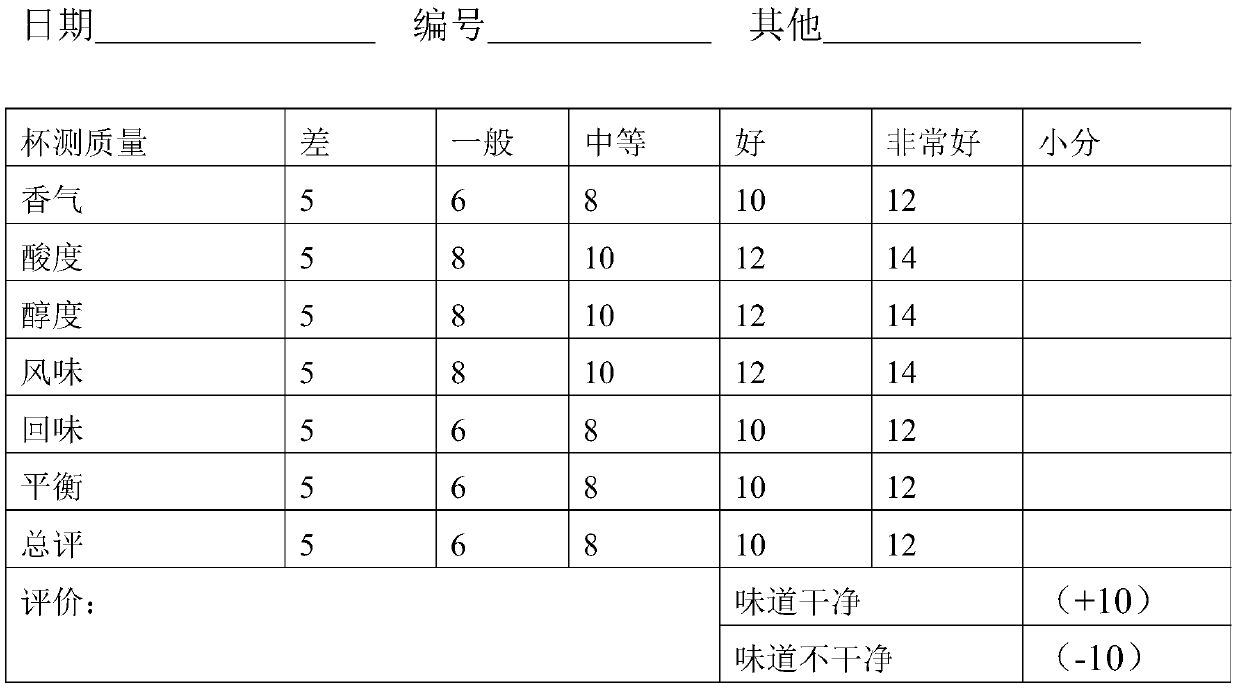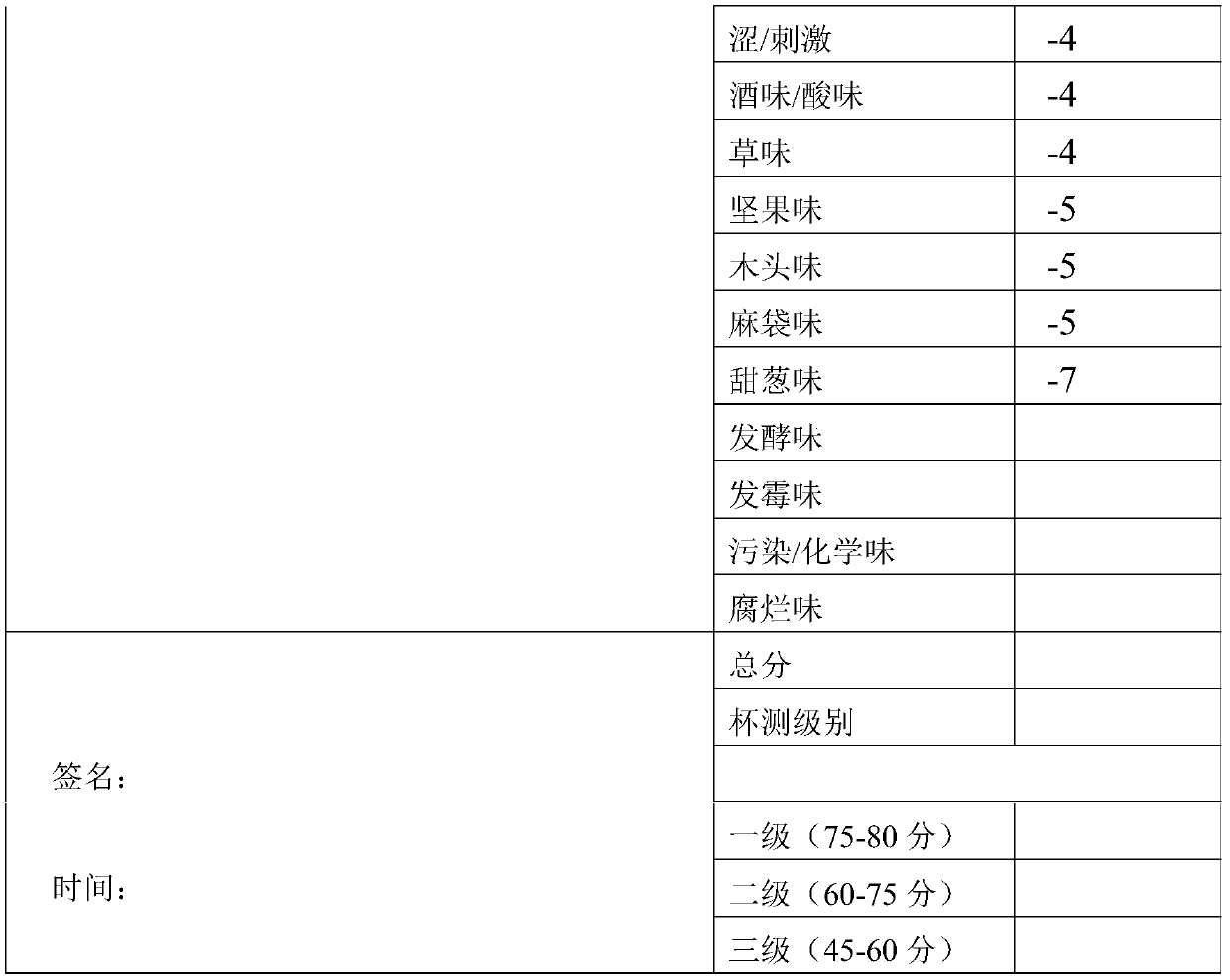Yellow honey processing method of coffee beans
A processing method, coffee bean technology, applied in the direction of green coffee processing, etc., can solve the problems of easy to produce peculiar smell, high price, long drying time, etc., achieve the effect of strong honey flower fragrance, reduce production cost, and short drying time
- Summary
- Abstract
- Description
- Claims
- Application Information
AI Technical Summary
Problems solved by technology
Method used
Image
Examples
Embodiment 1
[0033] A method for processing yellow honey of coffee beans, comprising the following steps:
[0034] (1) Selection of raw materials: picking fresh red coffee fruit with a maturity of 90%;
[0035] (2) Cleaning and peeling: After the fresh coffee cherries are cleaned with water, the moisture on the surface is filtered until the moisture is invisible to the naked eye, and then peeled to form peeled coffee cherries;
[0036] (3) Twice drying: put the peeled coffee cherries on the drying rack for the first drying for 2 days, do not turn the peeled coffee cherries during the first drying process, the peeled coffee cherries after the first drying The moisture content is 33%, and the color turns yellow; then the second drying is carried out for 2 days, and the peeled coffee cherries are repeatedly turned during the second drying process, and covered with plastic film at night to prevent them from being wet by dew. The moisture content of the dehulled coffee cherries after drying is...
Embodiment 2
[0040] A method for processing yellow honey of coffee beans, comprising the following steps:
[0041] (1) Selection of raw materials: picking fresh red coffee fruit with a maturity of 9.5%, the fruit is rosy and shiny, and the coffee beans are easy to come out of the peel with a light squeeze with your fingers. The altitude is not limited, and there is no fresh coffee fruit contaminated by microorganisms; picking There should be no water at the time, and there is no water stain on the surface of the fresh coffee fruit, and it has not been frosted; it is best to use the 4C standard fresh coffee fruit. Fresh coffee cherries harvested for the first time are not to be used. It is best to use fresh coffee berries harvested between Lidong to Xiaohan, and less to use between Xiaohan and Dahan. There is little mechanical damage; the fresh coffee fruit is in a fresh state without corruption.
[0042] (2) Cleaning and peeling: After cleaning the fresh coffee fruit with water, filter th...
Embodiment 3
[0047] A method for processing yellow honey of coffee beans, comprising the following steps:
[0048] (1) Selection of raw materials: picking fresh red coffee fruit with a maturity of 90%, the fruit is ruddy and shiny, and the coffee beans are easy to come out of the peel with a light squeeze with your fingers. The altitude is not limited, and there is no fresh coffee fruit contaminated by microorganisms; picking There should be no water at the time, and there is no water stain on the surface of the fresh coffee fruit, and it has not been frosted; it is best to use the 4C standard fresh coffee fruit. Fresh coffee cherries harvested for the first time are not to be used. It is best to use fresh coffee berries harvested between Lidong to Xiaohan, and less to use between Xiaohan and Dahan. There is little mechanical damage; the fresh coffee fruit is in a fresh state without corruption.
[0049] (2) Cleaning and peeling: After cleaning the fresh coffee fruit with water, filter th...
PUM
 Login to View More
Login to View More Abstract
Description
Claims
Application Information
 Login to View More
Login to View More - Generate Ideas
- Intellectual Property
- Life Sciences
- Materials
- Tech Scout
- Unparalleled Data Quality
- Higher Quality Content
- 60% Fewer Hallucinations
Browse by: Latest US Patents, China's latest patents, Technical Efficacy Thesaurus, Application Domain, Technology Topic, Popular Technical Reports.
© 2025 PatSnap. All rights reserved.Legal|Privacy policy|Modern Slavery Act Transparency Statement|Sitemap|About US| Contact US: help@patsnap.com


